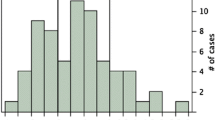Abstract
Objective
To evaluate general health condition of children operated for esophageal atresia, including complications from gastrointestinal tract and skeletal defects.
Methods
Between 1990 and 2005, 77 patients were operated for esophageal atresia in the Polish Mother’s Health Memorial Hospital. The study was based on retrospective analysis of medical case records of all children with esophageal atresia. All living patients (n=51) were invited for follow-up studies.
Results
Pathological gastroesophageal reflux was found in 46.7% of children. Scoliosis was diagnosed in 20 patients. Chest deformations were observed in 43.3% children
Conclusion
The absence of clinical symptoms does not exclude the presence of gastroesophageal reflux in children operated for esophageal atresia. Children operated for esophageal atresia should be followed up regularly by a multispecialistic medical team.
Similar content being viewed by others
References
Deurloo JA, Ekkelkamp S, Taminiau JA, Kneepkens CM, Ten Kate FW, Bartelsman JF, et al. Esophagitis and Barrett esophagus after correction of esophageal atresia. J Pediatr Surg. 2005;40:1227–31.
Kovesi T, Rubin S. Long-term complications of congenital esophageal atresia and/or tracheoesophageal fistula. Chest. 2004;126:915–25.
Koivusalo A, Pakarinen MP, Rintala RJ. The cumulative incidence of significant gastrooesophageal reflux in patients with oesophageal atresia with a distal fistula — a systematic clinical, pH-metric, and endoscopic follow-up study. J Pediatr Surg. 2007;42:370–74.
Engum SA, Grosfeld JL, West KW, Rescorla FJ, Scherer LR 3rd. Analysis of morbidity and mortality in 227 cases of esophageal atresia and tracheoesophageal fistula over two decades. Arch Surg. 1995; 130:5028.
Tovar JA, Diez Pardo JA, Murcia J, Prieto G, Molina M, Polanco I. Ambulatory 24-hour manometric and pH metric evidence of permanent impairment of clearance capacity in patients with esophageal atresia. J Pediatr Surg. 1995;30:1224–31.
Deurloo JA, Ekkelkamp S, Bartelsman JF, Ten Kate FJ, Schoorl M, Heij HA, et al. Gastroesophageal reflux: prevalence in adults older than 28 years after correction of esophageal atresia. Ann Surg. 2003;238:686–9.
Taylor AC, Breen KJ, Auldist A, Catto-Smith A, Clarnette T, Crameri J, et al. Gastroesophageal reflux and related pathology in adults who were born with esophageal atresia: a long-term follow-up study. Clin Gastroenterol Hepatol. 2007;5:702–6.
Sistonen SJ, Koivusalo A, Nieminen U, Lindahl H, Lohi J, Kero M, et al. Esophageal morbidity and function in adults with repaired esophageal atresia with tracheoesophageal fistula: a population-based long-term follow-up. Ann Surg. 2010;251:1167–73.
Guo W, Fonkalsrud EW, Swaniker F, Kodner A. Relationship of esophageal anastomotic tension to the development of gastroesophageal reflux. J Pediatr Surg. 1997;32:1337–40.
Sistonen SJ, Pakarinen MP, Rintala RJ. Long-term results of esophageal atresia: Helsinki experience and review of literature. Pediatr Surg Int. 2011;27:1141–49.
Sistonen SJ, Helenius I, Peltonen J, Sarna S, Rintala RJ, Pakarinen MP. Natural history of spinal anomalies and scoliosis associated with esophageal atresia. Pediatrics. 2009;124:e1198–204.
Dunlay RP, Jones KB, Weinstein SL. Scoliosis caused by rib fusion following thoracotomy for tracheoesophageal fistula: case report. Iowa Orthop J. 2007;27:95–8.
Chetcuti P, Myers NA, Phelan PD. Chest wall deformity in patient with repaired esophageal atresia. J Pediatr Surg. 1989;24:244–47.
Jaureguizar E, Vazquez J, Murcia J. Morbid musculoskeletal sequelae of thoracotomy for tracheoesophageal fistula. J Pediatr Surg. 1985;20:511–14.
Gilsanz V, Boechat IM, Birnberg FA. Scoliosis after thoracotomy for esophageal atresia. Am J Roentgenol. 1983;141:457–60.
Author information
Authors and Affiliations
Corresponding author
Rights and permissions
About this article
Cite this article
Koziarkiewicz, M., Taczalska, A., Jasiñska-Jaskula, I. et al. Long-term complications of congenital esophageal atresia–single institution experience. Indian Pediatr 52, 499–501 (2015). https://doi.org/10.1007/s13312-015-0664-4
Received:
Revised:
Accepted:
Published:
Issue Date:
DOI: https://doi.org/10.1007/s13312-015-0664-4




